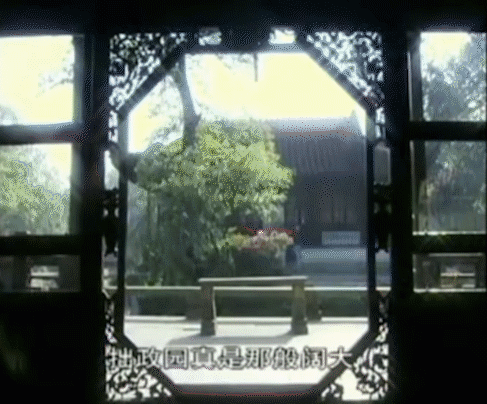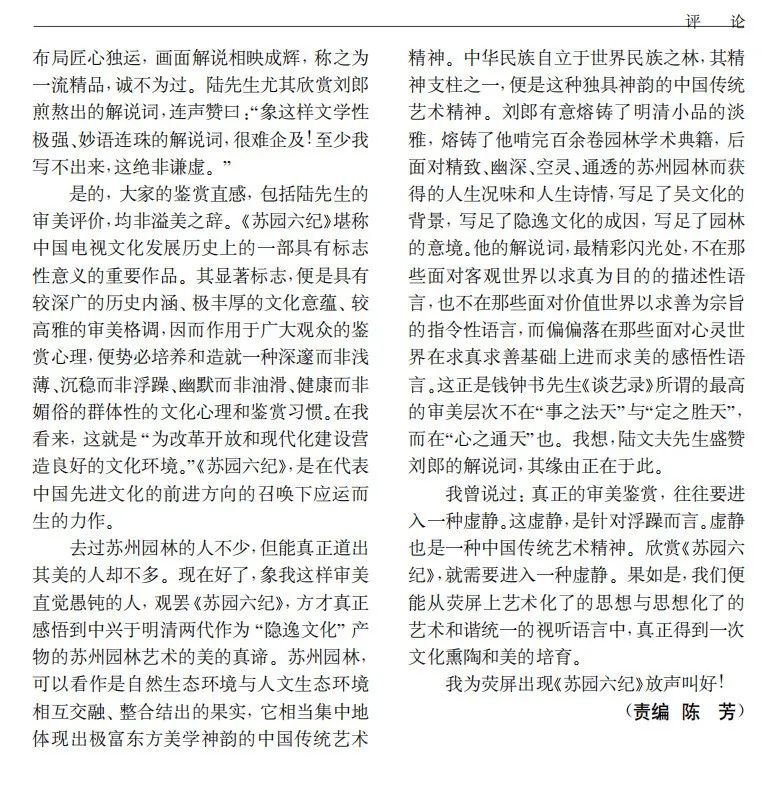
Editor's Note: “The Six Chronicles of Su Garden” is a large-scale, comprehensive, and systematic television documentary directed by Liu Lang, reflecting Suzhou gardens and exploring the profound cultural heritage of Wu culture from a humanistic and artistic perspective. The work premiered in 2000 and won the first prize for the special program (local group) at the 14th National Television Arts "Star Award," along with individual awards for excellent writing and cinematography.
On the occasion of the Mid-Autumn Festival, the "Revisiting Classics" channel aired “The Six Chronicles of Su Garden” for the first time. We are republishing commentary articles by the film's director Liu Lang and the renowned cultural critic Zhong Chengxiang, initiating a dialogue of ideas within the realms of art and scholarship. This exploration seeks to uncover the interesting stories behind the creation of “The Six Chronicles of Su Garden,” experience the harmonious blend of art and thought, and guide audiences to revisit this television art masterpiece rich in Eastern aesthetic charm.

[Creator's Insights]
Infused with Academic Pollen, Brewing the Honey of Television Art
● Liu Lang Director of “The Six Chronicles of Su Garden”
Writing about gardens is, in essence, writing about Wu culture.
The contemporary Suzhou cultural figure Mr. Lu Wenfu once said, "Art is a profession of tempering." Only those who have engaged in such endeavors can truly appreciate the depth of this philosophical statement. “The Six Chronicles of Su Garden,” in fact, was one of my most challenging projects.
The hardest part of making a cultural program is integrating academic reflections within the finite visuals of television. A cursory approach to garden art filmmaking is outdated and does not satisfy the current aesthetic demands of viewers. From the start of filming “The Six Chronicles of Su Garden,” we were clear that behind the gardens lies a rich Wu culture, encompassing a variety of categories and vivid hues while presenting a depth of social and historical context. Gardens serve as an elegant symbol and a unique vessel of Wu culture. More casual and superficial approaches cannot sufficiently carry these rich cultural connotations.
Generally, when any subject involves culture, it inevitably reveals profound meanings. If we delve too deep into academia, audiences immediately feel a disconnect; without academic rigor, experts find it too simplistic. The best perspective for a cultural program should be the reflection of the specific themes through the eyes of television creators. For many years, I have been pursuing and experimenting with the fusion of academia and art.
Gardens embody the reclusive lives of Ming and Qing scholars.
To create a compelling film about Suzhou gardens, one must grasp the key elements of Wu culture and revisit the topic of Ming and Qing scholars. While writings on Wu culture read as delightfully as savoring Suzhou cuisine, engaging with the studies of Ming and Qing scholars can be a more complex endeavor, akin to peeling a rice dumpling. Yet without in-depth research, no breakthrough in filming gardens can occur. Studying these historical materials ultimately aims to uncover the thematic essence of gardens—what exactly are they?
The true revival of classical Suzhou gardens occurred during the Ming and Qing dynasties. Mr. Lu Xun encapsulated this era's atmosphere, using the term "resentment," which reflects the harsh realities faced by scholars of the Ming dynasty. In response to these challenges, the gentry chose a suitable mode of retreat: reclusion, which became their expression of art. As garden scholars aptly put it, "Their reclusion was not into deep mountains and forests, but into art.” Suzhou gardens reflect the affluent, elegant, and tranquil lifestyle crafted by the scholarly gentry who once flourished before experiencing decline.
It must be acknowledged that relying solely on the outcomes and findings of experts is often insufficient when producing a cultural documentary. The intellectual depth must be thoughtfully and painstakingly distilled by the television creators themselves to be meaningfully transformed into the language of television; otherwise, the fusion of academic art and artistic scholarship cannot even begin. Only by immersing oneself in the rich pollen of knowledge can one ultimately brew the honey of distinctive television art.
Forging the Literary Style of the Ming and Qing Dynasties with a Title as the Key Stroke
The challenge of artisticizing academia inevitably presents itself during the scriptwriting phase. A true television writer wields the director's pen when drafting outlines. “The Six Chronicles of Su Garden” possesses a certain academic nature, which led me to deliberately infuse the subtle elegance of Ming and Qing literary pieces. When articulating garden art, there should be beauty in diction, charm in spoken language, and musical resonance; these elements are precisely the literary qualities of Ming and Qing writings.
Capturing Suzhou gardens in the format of a travelog can lead to superficiality; using a prose form risks vagueness; an introduction can result in accumulation of detail. Regardless of the chosen format, several essential content aspects must be included: the history of gardens, garden theory, garden appreciation, and notable figures associated with gardens. Once the overarching concept was established, we divided the artistic impressions of gardens into six chapters: “Wu Gate Mist and Water,” “Dividing Water and Carving Mountains,” “Deep Courtyards and Secluded Gardens,” “Listening to Rain by the Banana Window,” “Chapters of Time,” and “Wind Knocking on the Door Ring.” This way, we could broadly encompass all the main content related to gardens without omissions.
Sometimes, formulating the title is the hardest part. A good title must rely on one’s own wordsmithing; if “Suzhou Gardens” were to be the title, the documentary would likely fail. The name “The Six Chronicles of Su Garden” was almost conceived on the first day, and all those present during the discussion felt it was the most fitting title. The creative torment, validated by fellow creators, transformed into a lightness akin to floating Bi Luo Chun tea in my cup.
Restoring the Soul to the Shell of the Garden
Zhong Chengxiang once remarked, "True appreciation of art requires entering a state of tranquil emptiness." I find this to be very insightful. To appreciate the classical Suzhou gardens, one must enter a state of tranquility. Engaging with this garden environment cannot be approached with a meticulous and indifferent mindset; it is impossible to immerse oneself in the role. At least I felt in my scriptwriting phase how the influence of tranquility impacted creativity.
During my past life in the West, I was fortunate to collect calligraphy from several Suzhou figures. Although these authors have since passed, a lingering cultural aroma remains. To create ambiance while writing “The Six Chronicles of Su Garden,” I displayed these pieces on the wall. Somehow, I saw reflected in them my fellow colleagues who had contributed their hearts and sweat to this project. It was through our combined efforts that the creation of “The Six Chronicles of Su Garden” endeavored to restore the soul to the shell of the classical gardens.

[Critics' Perspective]
Experiencing the Harmonious Unity of Art and Thought
● Zhong Chengxiang Member of the Central Academy of History and Literature, renowned cultural critic
The Anecdote between Liu Lang and Lu Wenfu
The television art documentary directed by Liu Lang, from “The Temptation of Tibet” to “Jiangnan,” has earned accolades for its rich cultural connotation. This time, at the invitation of Suzhou Cable Television, after more than a year of challenges, he produced the documentary “The Six Chronicles of Su Garden,” which aims to "artisticize the academic study of gardens." I was filled with immense interest and traveled to Suzhou, where I met the renowned writer Mr. Lu Wenfu, whom I had long admired. I had heard that Mr. Lu devoted himself to writing novels and never "touched electricity," concerned it might disrupt his novelistic thinking. Director Xie Jin had repeatedly solicited Mr. Lu to write film scripts but had always been declined.
This time, something curious happened! When Suzhou Cable Television decided to bring the Suzhou gardens—recognized as a World Cultural Heritage by UNESCO—onto the screen, they found themselves lacking a talented leader for the creative team, and Mr. Lu Wenfu was the one who recommended Liu Lang for the job!
It turns out that while Liu Lang was directing “Jiangnan,” there was an episode titled “A Writer and a City.” The writer was none other than Mr. Lu, and the city was Suzhou. Liu Lang and Mr. Lu were strangers, but Liu Lang was deeply impressed by Mr. Lu’s elegant prose. Learning that Mr. Lu never "touched electricity" filled him with trepidation, but he mustered courage to make a phone call. Mr. Lu recalled, “When I picked up the phone and heard I was to be filmed, I tried to avoid it. But oddly enough, this Liu Lang whom I had never met spoke in a way that immediately struck me as a remarkable talent. That’s Liu Lang’s unique charm.”
The Beauty of Su Garden, Long Awaited!
After viewing “The Six Chronicles of Su Garden,” enthusiastic applause erupted in the audience. The work offered thought-provoking and moving reflections on the historical conditions, cultural background, aesthetic qualities, and artistic spirit of Suzhou gardens, skillfully crafted with a unique structure, complemented by vibrant visuals and narration. People exclaimed, “Such a deeply cultural and aesthetically refined television documentary has been long overdue!” Mr. Lu especially appreciated Liu Lang’s painstakingly crafted narration: “It’s challenging to achieve such a literary, eloquent script!”
The audience's evaluations, including Mr. Lu's aesthetic insights, were not mere flattery. “The Six Chronicles of Su Garden” embodies profound historical depth, rich cultural significance, and an elegant aesthetic style, which will surely cultivate a profound, non-superficial, calm, non-frantic, humorous, non-slick, and healthy, non-groveling cultural mentality and appreciation habit among viewers.
Having watched “The Six Chronicles of Su Garden,” one can genuinely appreciate the essence of the beauty in Suzhou garden art as a product of the revival in the Ming and Qing dynasties as “reclusive culture.” It intensely reflects the spirit of traditional Chinese art steeped in Eastern aesthetic charm.
In "Tranquility," Reaching the Heart's Sky
Liu Lang forged a vivid narrative infused with the essence he gleaned from studying over a hundred volumes of garden scholarship, confronting the exquisite, profound, ethereal, and transparent nature of Suzhou gardens and capturing the essence of Wu culture, the reasons behind reclusive culture, and the artistic ambience of gardens. His narration's most brilliant moments lie not in descriptive language aimed at objective truths or prescriptive language seeking moral good, but in the insightful language that strives for beauty based on the pursuit of truth and goodness. This aligns with what Qian Zhongshu referred to as the highest aesthetic level, which is not about “the law of things” or “the dominance of heaven,” but “the connection of the heart to heaven.”
I once said: True aesthetic appreciation often requires entering a state of tranquility. Tranquility exists as a counter to restlessness. Appreciating “The Six Chronicles of Su Garden” necessitates this tranquil mindset, allowing us to genuinely experience a cultural immersion and aesthetic cultivation through the harmonized audiovisual language of artful thought and thoughtful art presented on screen. I wholeheartedly applaud the appearance of “The Six Chronicles of Su Garden” on screen!
Appendix: "Chinese Television," Issue 9, 2000, "Artisticizing Garden Art: Commentary by Director Liu Lang on the Documentary 'The Six Chronicles of Su Garden'."
"Chinese Television," Issue 8, 2000, "The Artisticization of Thought and the Thought of Artisticization – Observations on the Documentary 'The Six Chronicles of Su Garden'” by Zhong Chengxiang.






